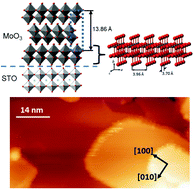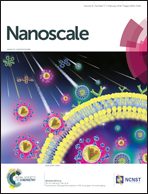Iso-oriented monolayer α-MoO3(010) films epitaxially grown on SrTiO3(001)†
Abstract
The ability to synthesize well-ordered two-dimensional materials under ultra-high vacuum and directly characterize them by other techniques in situ can greatly advance our current understanding on their physical and chemical properties. In this paper, we demonstrate that iso-oriented α-MoO3 films with as low as single monolayer thickness can be reproducibly grown on SrTiO3(001) substrates by molecular beam epitaxy ((010)MoO3‖(001)STO, [100]MoO3‖[100]STO or [010]STO) through a self-limiting process. While one in-plane lattice parameter of the MoO3 is very close to that of the SrTiO3 (aMoO3 = 3.96 Å, aSTO = 3.905 Å), the lattice mismatch along other direction is large (∼5%, cMoO3 = 3.70 Å), which leads to relaxation as clearly observed from the splitting of streaks in reflection high-energy electron diffraction (RHEED) patterns. A narrow range in the growth temperature is found to be optimal for the growth of monolayer α-MoO3 films. Increasing deposition time will not lead to further increase in thickness, which is explained by a balance between deposition and thermal desorption due to the weak van der Waals force between α-MoO3 layers. Lowering growth temperature after the initial iso-oriented α-MoO3 monolayer leads to thicker α-MoO3(010) films with excellent crystallinity.


 Please wait while we load your content...
Please wait while we load your content...